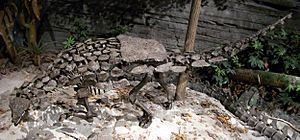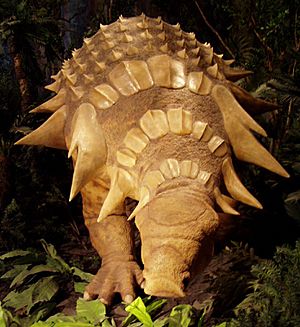Nodosaurids facts for kids
Quick facts for kids Nodosaurids |
|
|---|---|
 |
|
| A skeleton cast of Gargoyleosaurus | |
| Scientific classification |
|
| Kingdom: | Animalia |
| Phylum: | Chordata |
| Clade: | Dinosauria |
| Order: | †Ornithischia |
| Suborder: | †Ankylosauria |
| Family: | †Nodosauridae Marsh, 1890 |
| Subgroups | |
|
|
| Synonyms | |
|
Acanthopholididae Nopcsa, 1902 |
|
The Nodosauridae were a group of amazing dinosaurs that lived a very long time ago. They were a type of ankylosaur, which means "fused lizard." These dinosaurs lived from the Upper Jurassic (about 155 million years ago) to the Upper Cretaceous (about 66 million years ago). Their fossils have been found in rock layers, called strata, in places that are now North America, Asia, Antarctica, and Europe.
Unlike some other ankylosaurs, Nodosaurids did not have a big club-shaped tail. Instead, many of them had sharp spikes protecting their heads and shoulders. This armor helped keep them safe from predators.
All Nodosaurids, like other ankylosaurs, were medium to large-sized dinosaurs. They were heavily built and walked on four strong legs, so they were quadrupedal. They were herbivores, meaning they only ate plants. Their mouths had small, bumpy teeth, perfect for munching on leaves and other plants. Their bodies were covered with rows of bony plates, called osteoderms, which acted like natural armor.
Meet the Nodosaurids
Nodosaurids were part of a larger group called ankylosaurs. Scientists group them together because they share many features, especially their unique body armor. The Nodosaurid family includes many different kinds of dinosaurs, each with its own special look.
Where They Lived
Nodosaurids were found all over the world! Their fossils tell us they lived on several continents. For example, Edmontonia and Gargoyleosaurus lived in what is now Western North America. Hylaeosaurus was found in England, and Hungarosaurus lived in Central Europe.
Here are some of the known Nodosaurids and where their fossils were discovered:
- Animantarx (Utah, Western North America)
- Anoplosaurus (England, Northwestern Europe)
- Antarctopelta (James Ross Island, Antarctica)
- Edmontonia (Alberta, Western North America)
- Gargoyleosaurus (Wyoming, Western North America)
- Gastonia (Utah, Western North America)
- Hungarosaurus (Hungary, Central-Southern Europe)
- Hylaeosaurus (Sussex, Southern England)
- Nodosaurus (Wyoming and Kansas, Western North America)
- Panoplosaurus (Montana and Alberta, Western North America)
- Polacanthus (Isle of Wight and Sussex, Southern England)
- Sauropelta (Wyoming and Montana, Western North America)
- Struthiosaurus (Central-Southern Europe)
- Zhejiangosaurus (Zhejiang Province, Eastern China)
How Scientists Study Them
Scientists use a method called cladistics to understand how different dinosaurs are related. They look at shared features to build a "family tree" or cladogram. For Nodosaurids, this helps them figure out which dinosaurs are most closely related to each other. For example, the group Nodosauridae can be described as "all ankylosaurs closer to Panoplosaurus than to Ankylosaurus." This means Panoplosaurus shares more features with other Nodosaurids than with Ankylosaurus.
Images for kids
-
The amazing fossil of Borealopelta on display at the Royal Tyrrell Museum
See also
 In Spanish: Nodosauridae para niños
In Spanish: Nodosauridae para niños



